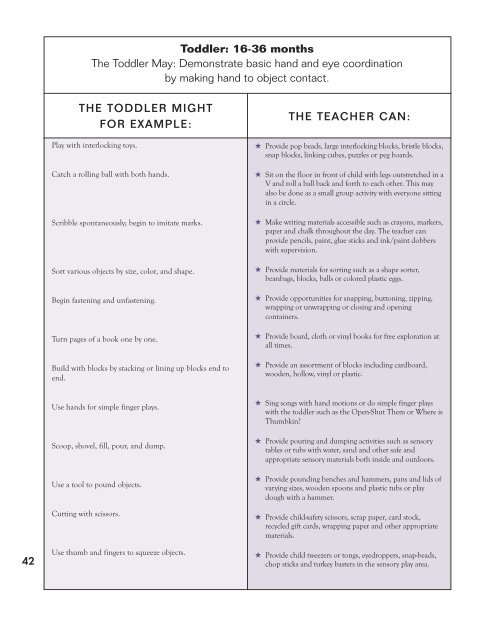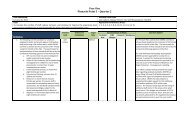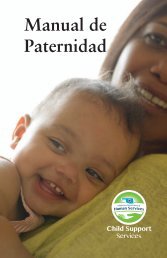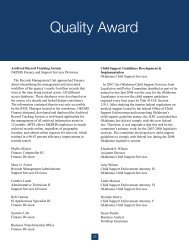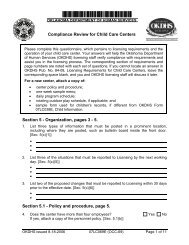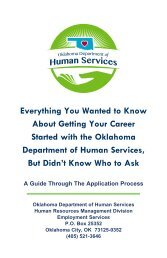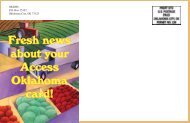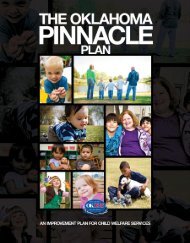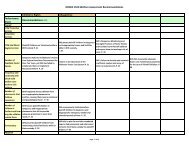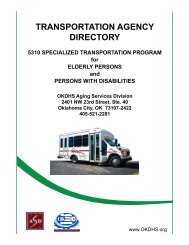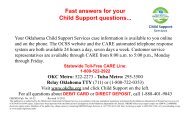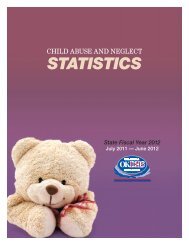Oklahoma Early Learning Guidelines for Infants, Toddlers and Twos
Oklahoma Early Learning Guidelines for Infants, Toddlers and Twos
Oklahoma Early Learning Guidelines for Infants, Toddlers and Twos
You also want an ePaper? Increase the reach of your titles
YUMPU automatically turns print PDFs into web optimized ePapers that Google loves.
42<br />
Toddler: 1636 months<br />
The Toddler May: Demonstrate basic h<strong>and</strong> <strong>and</strong> eye coordination<br />
by making h<strong>and</strong> to object contact.<br />
THE TODDLER MIGHT<br />
FOR EXAMPLE:<br />
Play with interlocking toys.<br />
Catch a rolling ball with both h<strong>and</strong>s.<br />
Scribble spontaneously; begin to imitate marks.<br />
Sort various objects by size, color, <strong>and</strong> shape.<br />
Begin fastening <strong>and</strong> unfastening.<br />
Turn pages of a book one by one.<br />
Build with blocks by stacking or lining up blocks end to<br />
end.<br />
Use h<strong>and</strong>s <strong>for</strong> simple finger plays.<br />
Scoop, shovel, fill, pour, <strong>and</strong> dump.<br />
Use a tool to pound objects.<br />
Cutting with scissors.<br />
Use thumb <strong>and</strong> fingers to squeeze objects.<br />
THE TEACHER CAN:<br />
★ Provide pop beads, large interlocking blocks, bristle blocks,<br />
snap blocks, linking cubes, puzzles or peg boards.<br />
★ Sit on the floor in front of child with legs outstretched in a<br />
V <strong>and</strong> roll a ball back <strong>and</strong> <strong>for</strong>th to each other. This may<br />
also be done as a small group activity with everyone sitting<br />
in a circle.<br />
★ Make writing materials accessible such as crayons, markers,<br />
paper <strong>and</strong> chalk throughout the day. The teacher can<br />
provide pencils, paint, glue sticks <strong>and</strong> ink/paint dobbers<br />
with supervision.<br />
★ Provide materials <strong>for</strong> sorting such as a shape sorter,<br />
beanbags, blocks, balls or colored plastic eggs.<br />
★ Provide opportunities <strong>for</strong> snapping, buttoning, zipping,<br />
wrapping or unwrapping or closing <strong>and</strong> opening<br />
containers.<br />
★ Provide board, cloth or vinyl books <strong>for</strong> free exploration at<br />
all times.<br />
★ Provide an assortment of blocks including cardboard,<br />
wooden, hollow, vinyl or plastic.<br />
★ Sing songs with h<strong>and</strong> motions or do simple finger plays<br />
with the toddler such as the OpenShut Them or Where is<br />
Thumbkin?<br />
★ Provide pouring <strong>and</strong> dumping activities such as sensory<br />
tables or tubs with water, s<strong>and</strong> <strong>and</strong> other safe <strong>and</strong><br />
appropriate sensory materials both inside <strong>and</strong> outdoors.<br />
★ Provide pounding benches <strong>and</strong> hammers, pans <strong>and</strong> lids of<br />
varying sizes, wooden spoons <strong>and</strong> plastic tubs or play<br />
dough with a hammer.<br />
★ Provide childsafety scissors, scrap paper, card stock,<br />
recycled gift cards, wrapping paper <strong>and</strong> other appropriate<br />
materials.<br />
★ Provide child tweezers or tongs, eyedroppers, snapbeads,<br />
chop sticks <strong>and</strong> turkey basters in the sensory play area.


